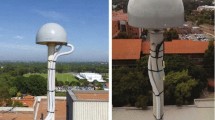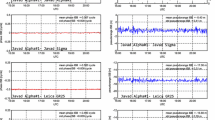Abstract
The availability of GPS signals is a major concern for many existing and potential applications. Fortunately, with the development of Galileo by the European Commission (EC) and European Space Agency (ESA) and new funding for the restoration of the Russian GLONASS announced by the Russian Federation (Revnivykh et al., in European Navigation Conference 2005, Munich, Germany, July 19–22), the future for satellite-based positioning and navigation applications is extremely promising. With the complete cooperation from all these global navigation satellite systems (GNSS), greater levels of satellite visibility and therefore integrity can be expected. In this paper, a receiver autonomous integrity monitoring (RAIM) scheme along with reliability and separability measures are used to assess integrity performance levels of standalone GPS and integrated GPS/GLONASS, GPS/Galileo and GPS/GLONASS/Galileo systems where the clock offsets for each of the additional systems are estimated. It is shown, herein, that a minimum of three satellites must be visible in an additional system in order to provide a full integrity contribution when the system’s clock offset is to be estimated within the adjustment. A comparison of the integrity results obtained via system clock offsets estimated in the adjustment versus the case where the offsets are known and the measurements are corrected prior to the adjustment is also made for a high elevation mask scenario. Global simulation results for combined GPS/GLONASS/Galileo show that, theoretically, for the time of simulation and for any point on the globe, an outlier of 20 m can be detected with 80% probability at the 0.5% significance level and then separated from any other measurement with 90% probability. Corresponding values for the GPS only and combined GPS/GLONASS and GPS/Galileo systems, respectively, are approximately 435, 110 and 28 m, respectively, for the maximum MSBs and 312, 50 and 26 m, respectively, for the maximum MDBs. Temporal 24 h simulations for the GPS/GLONASS/Galileo scenario delivered agreeable results with the global snapshots for a 15° elevation mask. For the case where system clock offsets are estimated within the adjustment, it was shown that only the reliability measure was available for 100% of the time, with horizontal external reliability values of no more than about 12 m when a 30° masking angle was used. By assuming the clock offsets were determined and corrected for prior to the adjustment, the separability measure was markedly improved and was also available 100% of the time.
















Similar content being viewed by others
References
Baarda W (1968) A testing procedure for use in geodetic networks, Netherlands Geodetic Commission, New Series, vol 2, no. 4
Blomenhofer H, Ehret W, Blomenhofer E (2004) Consideration of operational outages in Galileo and GPS integrity analysis. In: The European Navigation Conference GNSS 2004, Rotterdam, Netherlands 81:1–12
Cross PA, Hawksbee DJ, Nicolai R (1994) Quality measures for differential GPS positioning. Hydrogr J Hydrogr Soc 72:17–22
Dinwiddy SE, Breeuwer E, Hahn JH (2004) The Galileo System. In: The European Navigation Conference GNSS 2004, Rotterdam, Netherlands, 151:1–5
Förstner W (1983) Reliability and discernability of extended Gauss–Markov models. Deutsche Geodätische Kommission (DGK), Report A 98:79–103
Galileo Mission High Level Mission Definition Version 3.0 (2002) European Commission and European Space Agency http://www.europa.eu.int/comm/dgs/energy_transport/galileo/documents/technical_en.htm
GLONASS Interface and Control Document Version 5.0 (2002) Coordinational Scientific Information Center, Russian Federation Ministry of Defense. http://www.glonass-center.ru/public_e.html
Hewitson S (2003) GNSS receiver autonomous integrity monitoring: a separability analysis, ION GPS/GNSS 2003, Portland, Oregon, September 9–12, pp 1502–1509
Hewitson S, Lee HK, Wang J (2004) Localizability analysis for GPS/Galileo receiver autonomous integrity monitoring. J Navigation R Inst Navigation 57:245–259
Hein GW, Pielmeier J, Zink T, Eissfeller B (1997) GPS and GLONASS RAIM availability analysis over Europe, ION GPS-97, Kansas City, Missouri, September 16–19, pp 465–474
Intergovernmental Committee on Surveying and Mapping (2002) Standards and Practices for Control Surveys (http://www.icsm.gov.au/icsm/publications/sp1/sp1.htm). Web site accessed 29 August 2005
Lee HK, Wang J, Rizos C, Barnes J, Tsujii T, Soon BKH (2002) Analysis of Pseudolite Augmentation for GPS Airborne Application. ION GPS 2002, Portland, Oregon, September 24–27, pp 2610–2618
Lee YC (2004) Investigation of extending Receiver Autonomous Integrity Monitoring (RAIM) to combined use of Galileo and Modernized GPS, ION GNSS 2004, Long Beach, California, September 21–24:1691–1698
Li DR (1986) Trenbarkeit and Zuverlaessigkeit bei zwei verschiedenen Alternativehypothesen im Gauss-Markov Modell. ZfV 3:114–128
Merino MMR, Alarcón AJG, Villares IJ, Monseco EH (2001) An integrated GNSS concept, Galileo and GPS, benefits in terms of Accuracy, Integrity, Availability and Continuity, ION GPS 2001, Salt Lake City, UT, 11–14 September, pp 2114–2124
Moore M, Rizos C, Wang J (2002) Quality control issues relating to an attitude determination system using a multi-antenna GPS array. Geomat Res Australasia 77:27–48
Moudrak A, Konovaltsev A, Furthner J, Hammesfahr J, Defraigne P, Bauch A, Bedrich S, Schroth A (2005) Interoperability on time, GPS World, March, 7 pages http://www.gpsworld.com/gpsworld/article/articleDetail.jsp?id=151131
Ober PB (2003) Integrity prediction and monitoring of navigation systems. Integricom Publishers, Leiden
Ochieng WY, Sheridan KF, Sauer K, Han X, Cross PA, Lannelongue S, Ammour N, Petit K (2002) An assessment of the RAIM performance of a combined Galileo/GPS navigation system using the marginally detectable errors (MDE) algorithm. GPS Solutions 5(3):42–51
O’Keefe K (2001) Availability and reliability advantages of GPS/Galileo integration, ION GPS 2001, Salt Lake City, Utah, September 11–14, pp 1–10
Ryan S, Lachapelle G (2000) Impact of GPS/Galileo Integration on Marine Navigation. In: IAIN World Congress/ION Annual Meeting, pp 721–731
Revnivykh S, Klimov V, Kossenko V, Dvorkin V, Tyulyakov A (2005) Status and development of GLONASS. In: European Navigation Conference 2005, Munich, Germany, July 19–22
Teunissen PJG (1998) Quality control and GPS. In: Teunissen PJG, Kleusberg A (eds) GPS for Geodesy, 2nd edn. Springer, Berlin Heidelberg New York
Tiberius CCJM (1998) Quality control in positioning. Hydrogr J 90:3–8
Verhagen S (2002) Performance analysis of GPS, Galileo and integrated GPS-Galileo, ION GPS 2002, Portland, Oregon, September 24–27, pp 2208–2215
Wang J, Chen Y (1994) On the localizability of blunders in correlated coordinates of junction points in densification networks. Aust J Geod Photogram Surv 60:109–119
Author information
Authors and Affiliations
Corresponding author
Rights and permissions
About this article
Cite this article
Hewitson, S., Wang, J. GNSS receiver autonomous integrity monitoring (RAIM) performance analysis. GPS Solut 10, 155–170 (2006). https://doi.org/10.1007/s10291-005-0016-2
Received:
Accepted:
Published:
Issue Date:
DOI: https://doi.org/10.1007/s10291-005-0016-2




